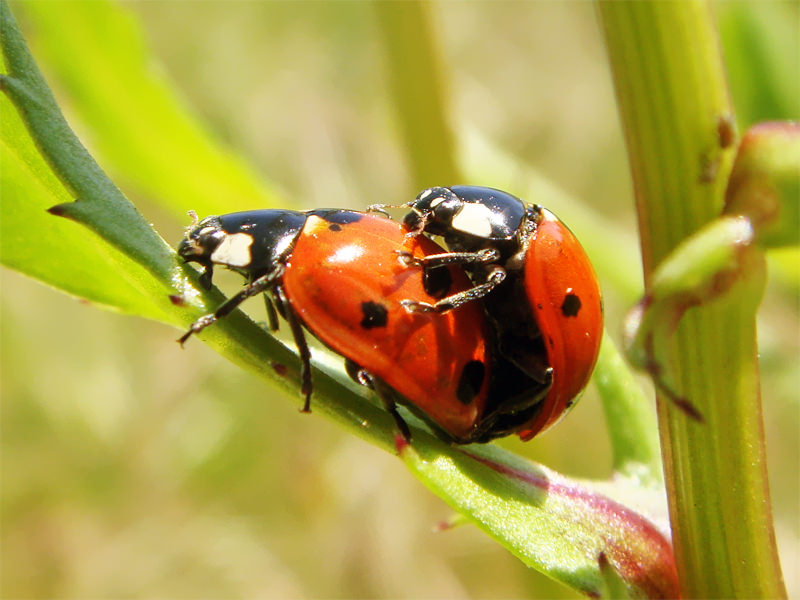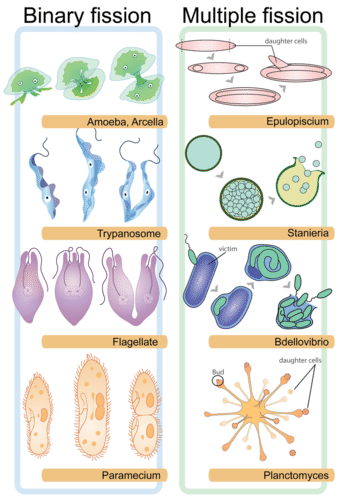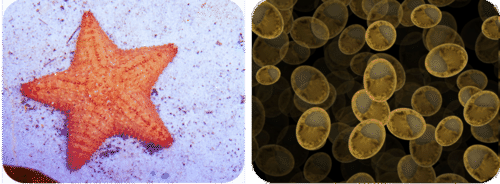性生殖 -- -- 高级
章节大纲
-
One parent or two?
::单亲还是双亲?That is the main difference between sexual and asexual reproduction. is combining genetic material from two parents, usually from two gametes . How the two combine may take many forms, but does not necessarily involve physical contact. Sexual reproduction produces offspring that are genetically distinct from other offspring and from their parents. Asexual reproduction produces offspring from just one parent. These offspring are genetically identical to that one parent.
::这是性生殖和性生殖的主要区别。 将双亲的遗传材料(通常来自两个调子)结合起来。 两者的结合方式可以有多种形式,但不一定涉及身体接触。 性生殖产生与其他后代及其父母在遗传上不同的后代。 性生殖只产生一个父母的后代。 这些后代在遗传上与一个父母完全相同。Reproduction
::复制复制Some organisms look and act exactly like their parent. Others share many similar traits, but they are definitely unique individuals. Some have two parents, whereas others have just one. How an organism reproduces determines the amount of similarity the organism will have to its parent. is the process by which organisms give rise to offspring. It is one of the defining characteristics of living things. There are two basic types of reproduction: asexual reproduction and sexual reproduction. Each of these processes ensures that the parental generation gives genetic material, , to its offspring.
::有些生物与父母长相相似,另一些生物与父母长相相似,但具有许多相似的特性,但都是独特的个体。有些生物有双亲,而另一些则只有一个。生物的繁殖如何决定生物与父母的相似性。生物的繁殖过程是生物产生后代的过程。生物的特性是生命的决定性特征之一。生殖有两种基本类型:性生殖和性生殖。每一种过程都确保父母的一代向后代提供遗传物质。The process of is how grow and repair themselves. It is also how many organisms produce offspring. For many single-celled organisms, asexual reproduction is a similar process. The parent cell simply divides to form two daughter cells that are identical to the parent. Asexual reproduction produces offspring that are genetically identical to the parent, whereas sexual reproduction produces a similar, but genetically unique offspring. In sexual reproduction, produces haploid gametes that fuse during to produce a diploid zygote ( Figure ). In other words, a child inherits half of the genetic material from each parent. Look at the family in Figure . The children resemble their parents, but they are not identical to them. Instead, each has a unique combination of characteristics inherited from both parents. The children, of course, result from sexual reproduction.
::过程是如何成长和自我修复, 也是有多少有机体产生后代。 对于许多单细胞生物来说, 性生殖是一个相似的过程。 父细胞只是分裂成两个与父母相同的女儿细胞。 性生殖产生与父母遗传相同的后代, 而性生殖产生相似但遗传上独特的后代。 在性生殖中, 产生杂碎的游戏, 产生一个低脂的zygote( Figure ) 。 换句话说, 一个孩子继承了每个父母一半的遗传材料。 图中显示的是家庭。 孩子们与父母相似, 但他们与父母不同。 相反, 每一个孩子都有独特的组合, 由双亲继承的特性。 当然, 子女是性生殖的结果。Fertilization of an egg cell by a sperm cell. In sexual reproduction, haploid gametes fuse to produce a diploid zygote.
::精子细胞对卵细胞施肥,在性生殖中,手动游戏引信可产生泡泡酶。Family Portrait: Mother, Daughter, Father, and Son. Children resemble their parents, but they are never identical to them. Do you know why this is the case?
::家庭肖像:母亲、女儿、父亲和儿子。孩子与父母相似,但他们从来不和父母完全一样。你知道为什么会这样吗?Asexual Reproduction
::性生殖Do animals always have two parents?
::动物总是有双亲吗?No, not all have two parents. Sometimes animals can be made from just one parent. This Komodo dragon, for example, only has a mother and reproduces by parthenogenesis . Asexual reproduction is the process of creating offspring from just one parent.
::不,不是所有人都有双亲。有时动物可以只由父母一方来制造。例如,科莫多龙只拥有母亲,其繁殖由同父异母产生。性生殖是只由父母一方来创造后代的过程。Are there male and female ? How could you tell? Remember, bacteria have just one ; they do not have an X or Y chromosome . So they probably have a very simplified form of reproduction. Asexual reproduction, the simplest and most primitive method of reproduction, involves a single parent and produces a clone , an organism that is genetically identical to the parent. Haploid gametes are not involved in asexual reproduction. A parent passes all of its genetic material to the next generation. All prokaryotic and some eukaryotic organisms reproduce asexually.
::有男性和女性吗?你怎么知道呢?记住,细菌只有一个;没有X或Y染色体。因此,它们可能有一个非常简单的生殖形式。性生殖是最简单和最原始的生殖方法,它涉及单亲,产生一个克隆人,一个基因与母体相同的生物体。嗜血类复变没有涉及性生殖。父母将所有遗传物质传给下一代。所有蛋白质生物和一些乳腺生物都是性繁殖的。Asexual reproduction can be very rapid. This is an advantage for many organisms. It allows these organisms to crowd out other organisms that reproduce more slowly. Bacteria, for example, may divide several times per hour. Under ideal conditions, 100 bacteria can divide to produce millions of bacterial cells in just a few hours. However, most bacteria do not live under ideal conditions. If they did, the entire surface of the planet would soon be covered with them. Instead, their reproduction is kept in check by limited resources, predators , and their own wastes. This is true of most other organisms as well.
::性生殖可以非常迅速。 这是许多生物的优势。 它允许这些生物排挤其他繁殖速度较慢的生物。 例如细菌, 细菌每小时可能分裂数倍。 在理想条件下, 100 细菌可以在短短几个小时内分裂成数以百万计的细菌细胞。 然而, 大多数细菌并不生活在理想条件下。 如果是这样, 整个地球表面很快就会被它们覆盖。 相反, 它们的繁殖会受到有限的资源、 捕食者 和他们自己的废物的制约。 对于大多数其它生物来说也是如此。There are a number of types of asexual reproduction including fission, fragmentation , budding , , spore formation and agamogenesis. Spore formation occurs in plants, and some and , and will be discussed in additional concepts.
::性生殖有多种类型,包括裂变、分裂、萌芽、卵巢形成和诱发。 剧情形成发生在植物中,有些和(或),并将在其他概念中加以讨论。Binary Fission in various single-celled organisms (left). Cell division is a relatively simple process in many single-celled organisms. Eventually the parent cell will pinch apart to form two identical daughter cells. In multiple fission (right), a multinucleated cell can divide to form more than one daughter cell. Multiple fission is more often observed among protists.
::在各种单细胞生物(左)中,细胞分裂是一个相对简单的过程,在许多单细胞生物中,细胞分裂是一个相对简单的过程,最终母细胞将分裂成两个完全相同的女儿细胞。在多核裂变(右)中,多核细胞可以分裂成一个以上女儿细胞。在预科人中,多核裂变更常见。Fission
::分裂In fission (or binary fission), a parent separates into two or more individuals of about equal size. This type of reproduction is common among single-celled organisms including bacteria, , and unicellular eukaryotes , such as and some fungi. The single cell divides into two daughter cells.
::在裂变(或二元裂变)中,父母一方分离成两个或两个以上大小大致相等的个人,这种生殖方式在单细胞生物中很常见,包括细菌、细菌和单卵巢,例如和一些真菌。单细胞分为两个女儿细胞。Fragmentation
::碎片化In fragmentation , a body breaks into several fragments, which later develop into complete organisms. For example, a new starfish ( Figure ) can develop from a single ray, or arm. In addition to starfish, this type of reproduction is common among some worms, fungi and plants. Many of these organisms are also capable of sexual reproduction. Most lichens, which form from a symbiotic relationship between a fungus and photosynthetic algae or bacteria, reproduce through fragmentation. This ensures that new individuals contain both symbionts.
::在碎裂中,身体分解成若干碎片,然后发展成完整的生物,例如,新的海星鱼(图)可以从单一的射线或手臂中发展出来;除了海星鱼之外,这种繁殖在某些蠕虫、真菌和植物中也很常见;许多这些生物也可以进行性繁殖;大多数地衣是菌类和光合藻或细菌之间的共生关系形成的,通过碎裂繁殖;这确保新的人既含有共生生物,又含有共生生物。Budding
::达丁In budding , organisms reproduce by having new individuals split off from existing ones, which results in genetically identical parent and daughter organisms. The bud may stay attached or break free from the parent. Eukaryotic organisms, such as the single cell yeast and multicellular hydra, undergo budding ( Figure ).
::在萌芽期,生物通过让新的个体与现有个体分离而繁殖,从而产生在遗传上与母体和母体相同的母体和女体。芽可以保持与母体的连接或断开。如单细胞酵母和多细胞水合体等单细胞酵母和多细胞水合体的生物正在发育(图 ) 。Starfish reproduce by fragmentation and yeasts reproduce by budding. Both are types of asexual reproduction.
::海星通过碎裂繁殖,酵母通过芽繁殖,两者都是性生殖类型。Vegetative Reproduction
::植物复制Vegetative reproduction is a type of asexual reproduction found in plants. This type of reproduction occurs when new individuals are formed without the production of seeds or spores. The formation of new plants out of rhizomes or stolons is an example of vegetative reproductive, such as in the strawberry plant. Other plants use this type of reproduction to reproduce through bulbs or tubers, or shoots and suckers that form along lateral . See the Plant Biology concepts for additional information.
::在植物中发现的一种性生殖方式是植物中的生殖方式,这种生殖方式是在没有生产种子或种子的情况下形成新的人时发生的;在青黄瓜或石瓜中形成新的植物是植物生殖方式的一个例子,例如在草莓植物中;其他植物则使用这种生殖方式通过灯泡或管子复制,或者通过横向形成的射击和吸尘器进行繁殖;请参看植物生物学概念,以了解更多信息。These strawberry plants reproduce by vegetative reproduction. New strawberries grow out of stolons, a specialized type of horizontal above-ground shoot.
::这些草莓植物以植物繁殖方式繁殖。新的草莓生长在石瓜上,一种特殊的横向地面射击。Agamogenesis
::起源Agamogenesis is any form of reproduction that does not involve a male gamete. These include are parthenogenesis and apomixis. Parthenogenesis is a form of asexual reproduction where growth and of embryos occur without fertilization. Parthenogenesis occurs naturally in aphids, rotifers, nematodes and some other invertebrates , as well as in many plants and certain lizards, such as the Komodo dragon. Apomixis is asexual reproduction, without fertilization, in plants.
::胚胎的产生是一种性生殖形式,其生长和胚胎在没有受精的情况下发生,其产生自然地发生在两栖动物、旋翼动物、线虫和其他无脊椎动物,以及许多植物和某些蜥蜴,如科莫多龙。Asexual Reproduction Summary Type Description Example Organisms Fission Occurs when a parent cell splits into two identical daughter cells of the same size. Bacteria, Protists, Unicellular Fungi Fragmentation Occurs when a parent organism breaks into fragments, or pieces, and each fragment develops into a new organism. Starfish, some worms, fungi, plants, lichens Budding Occurs when a parent cell forms a bubble-like bud. The bud stays attached to the parent cell while it grows and develops. When the bud is fully developed, it breaks away from the parent cell and forms a new organism. Yeast, Hydra Vegetative Reproduction Occurs when new individuals are formed without the production of seeds or spores. Plants Agamogenesis Any form of reproduction that does not involve a male gamete. Many plants and some animals. Summary
::摘要-
Asexual reproduction involves one parent and produces offspring that are genetically identical to each other and to the parent.
::性生殖涉及父母一方,产生在遗传上与父母和父母完全相同的后代。 -
Numerous types of asexual reproduction exist, including fission, fragmentation and budding.
::存在多种类型的性生殖,包括裂变、分裂和萌芽。 -
Bacteria and single-celled eukaryotic organisms must reproduce asexually, however, numerous multi celled organisms also reproduce asexually.
::细菌和单细胞电子水晶生物体必须进行性繁殖,然而,许多多细胞生物体也进行性繁殖。
Review
::回顾-
What is reproduction?
::什么是生殖? -
Describe three types of asexual reproduction.
::描述三种性生殖。 -
Define gamete and zygote. What number of chromosomes does each have?
::定义 gamete 和 zygote 。 每个染色体有多少 ? -
Compare and contrast asexual and sexual reproduction.
::比较和对比非性生殖和性生殖。
-
Asexual reproduction involves one parent and produces offspring that are genetically identical to each other and to the parent.






